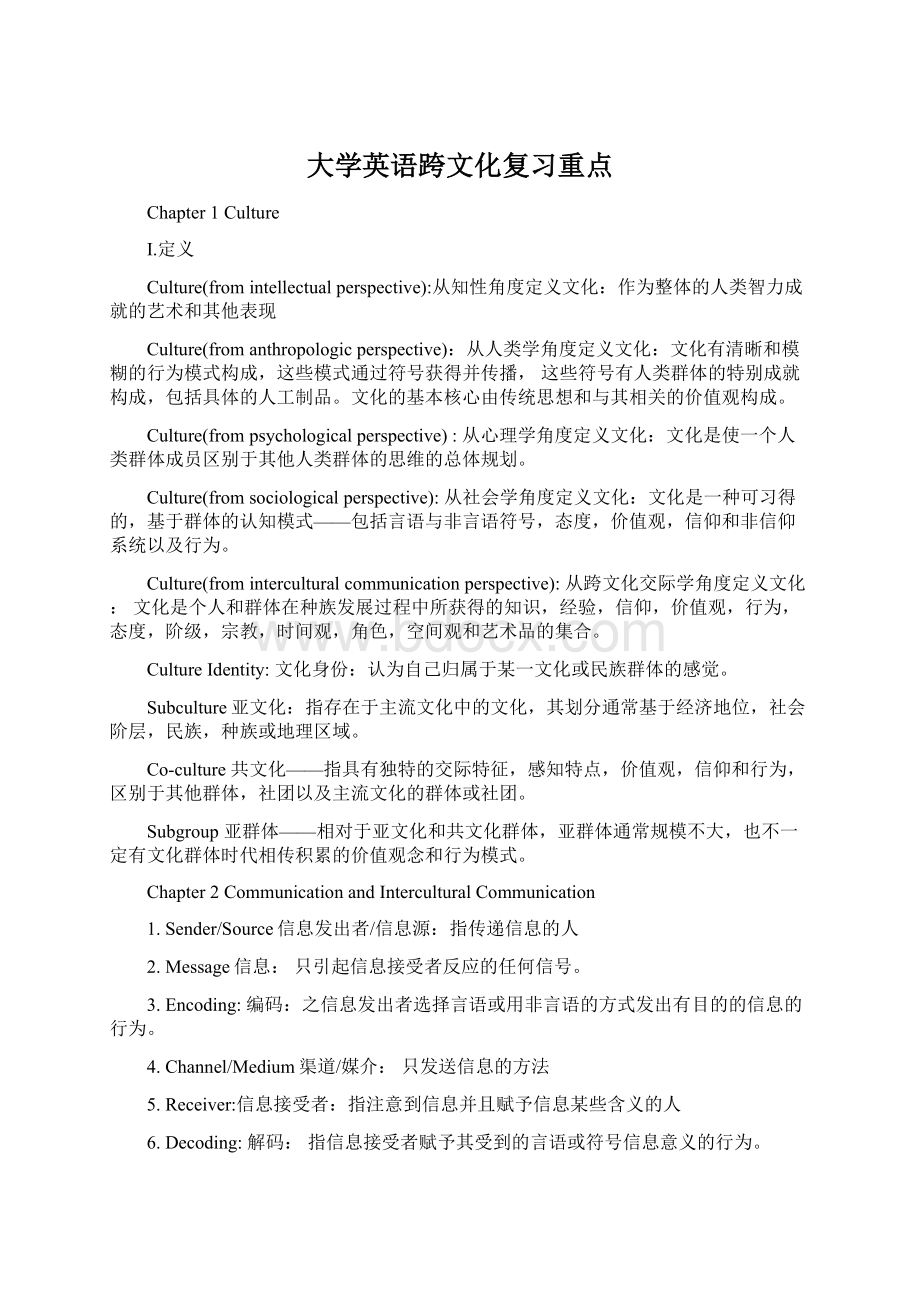 大学英语跨文化复习重点Word下载.docx
大学英语跨文化复习重点Word下载.docx
- 文档编号:20965997
- 上传时间:2023-01-26
- 格式:DOCX
- 页数:12
- 大小:27.77KB
大学英语跨文化复习重点Word下载.docx
《大学英语跨文化复习重点Word下载.docx》由会员分享,可在线阅读,更多相关《大学英语跨文化复习重点Word下载.docx(12页珍藏版)》请在冰豆网上搜索。

指存在于主流文化中的文化,其划分通常基于经济地位,社会阶层,民族,种族或地理区域。
Co-culture共文化——指具有独特的交际特征,感知特点,价值观,信仰和行为,区别于其他群体,社团以及主流文化的群体或社团。
Subgroup亚群体——相对于亚文化和共文化群体,亚群体通常规模不大,也不一定有文化群体时代相传积累的价值观念和行为模式。
Chapter2CommunicationandInterculturalCommunication
1.Sender/Source信息发出者/信息源:
指传递信息的人
2.Message信息:
只引起信息接受者反应的任何信号。
3.Encoding:
编码:
之信息发出者选择言语或用非言语的方式发出有目的的信息的行为。
4.Channel/Medium渠道/媒介:
只发送信息的方法
5.Receiver:
信息接受者:
指注意到信息并且赋予信息某些含义的人
6.Decoding:
解码:
指信息接受者赋予其受到的言语或符号信息意义的行为。
7.Feedback:
反馈“指信息接受者对信息源信息所作出的反应。
8.Noise:
干扰:
指妨碍信息交流的各种因素。
包括外界干扰,生理干扰,心理干扰和语义干扰。
9.Context:
语境,指交际发生的环境,包括自然语境,社会语境和人际语境。
10.Interculturalcommunication:
跨文化交际,指的是那些在卫华人之和符号系统上存在差异的人们之间的交际。
这些差异足以改变整个交际事件。
11.Internationalcommunication:
国际交流,指发生在国家和政府之间而非发生在个人之间的交际,此种交际非常正式和仪式化。
12.Interracialcommunication:
跨种族交际,指交流信息的信息源和信息接受者来自不同的种族的交际。
13.Interethniccommunication:
跨民族交际:
来自一个国家或文化内部的不同民族群体的人们之间的交际。
14.Interculturalcommunication:
文化内交际指统一文化内部的成员之间的交际。
Chapter3Culture’sInfluenceonPerception
1.Sensation:
感觉,是人们意识到周围环境的神经过程。
2.Perception知觉:
是一种人们通过各种感觉来觉察事物,事件,任何人的行为的过程。
它是解释感觉信息更为高价的认知过程。
3.Selection:
选择,是从周围的选择的刺激信息中筛选出所需要的信息的过程。
4.Organization组织:
是把从周围选择的刺激信息,以一种有意义的方式整理,组合的过程。
5.Interpretation:
释义,是赋予感觉信息意义的过程,类似于解码过程。
Chapter4InterculturalCommunicationBarriers
1.Anxiety:
焦虑,当人们不知道如何迎合他人对自己的期待,过多的关注自己情绪以至不能全心投入到交际事物中去时,就会产生焦虑。
2.Uncertainty:
不确定,是指人们无法从认知的角度去解释交际活动中自己或他人的感觉及行为,这种认知角度解释能力的欠缺是某种引起焦虑的含糊情镜导致的。
3.Assumingsimilarityinsteadofdifference:
假定一致性,是指认为来自另一文化的他人和自己相似或他人的处境与自己处境的相似,儿事实上却并非如此。
4.Ethnocentrism:
民族优越感,只从本国文化得标准出发,消极地审视另一文化。
5.Stereotypes:
文化定势,指基于明显的或受到认可的群体身份,对目标群体中的个体成员所持有的正面或反面的判断。
6.Prejudice:
偏见,指对于某一特定群体,种族,宗教,或性取向的无端地憎恶和怀疑。
7.Racism:
种族主义,指基于种族把性格特点或地位归因于个人的任意政策,做法,信仰或态度。
Chapter5VerbalInterculturalCommunication
Verbalinterculturalcommunication:
来自不同文化北京的人用言语进行的交际即言语跨文化交际。
Dialect:
方言指某一群体特有的语言,与整个群体的言语不同。
Sociolect:
社会方言指由于社会阶级或言语分割不同而产生的方言。
Pidgin:
洋泾浜;
是一种特殊的语言变体,指为贸易等目的将两种或几种语言混合使用。
Creole:
当有人以洋泾浜为母语,并成为某一地区永久的语言时,它就成为克里奥尔语或混合语。
Linguafranca:
通用语指作为国际间交流手段的一种特殊语言。
Taboo:
禁忌语指被禁止或避免的具有毛反省的不礼貌行为。
Euphemism:
委婉语是替代具有毛反省的不礼貌的禁忌语词语。
Jargon:
行话是指演变而来的专门的或科技词汇,用以满足特殊职业的特殊需要,例如医药或法律。
Chapter6NonverbalInterculturalCommunication
Nonverbalcommunication:
非言语交际:
不运用言语语言传递信息。
Proxemics:
时空行为是指对空间关系的研究。
Chronemics:
时间行为是对于人们如何理解和利用时间的研究。
Paralanguage:
为增强其含义,伴随言语语言产生的可听到的声音符号系统。
Olfactics:
气味行为:
研究气味对于交流的影响的学科
Oculesics:
目光语:
对于有眼睛所传达的信息的研究。
不同的文化对于交际时眼神的接触有不同的要求。
Haptics:
触觉行为:
指通过身体接触来交流。
Chromatics:
色彩学:
指对于影响人们人之,行为和他人印象的色彩的研究。
Kinesics:
身势语:
指手势,面目表情,眼神交流,身体姿势,肢体运动和问候方式以及它们与交际的关系。
Chapter7CulturalPatterns
Culturalpatterns:
文化模式是指相对稳定的共有的信仰,价值观,标准和社会实践,这些文化模式在相似的情形下会使人产生相似的行为。
Context:
语境是指事件发生时周围的信息,对事件的解读具有重要参考价值。
HighContextCommunication:
高语境交际是指在交际过程中大部分的信息靠交际人本身传递,只有少量信息被明确地用语言的形式传递。
LowContextCommunication:
低语境交际是指大量的信息通过明确的语言编码被传递的交际。
UncertaintyAvoidance:
不确定性规避是指某一文化的成员对不确定性因素的规避程度。
PowerDistance:
权力距离是指机构或组织中权利较小的成员对权力被不平等分配的接受程度。
Chapter8CulturalInfluencesonContexts
Communicationcontext:
交际语境,交际无法脱离外部环境的影响,所有的人类交接都或多或少受到社会,物理和文化场景的影响,这些场景成为交际语境。
Chapter9InterculturalAdaptation
1.Acculturation文化适应:
指人们学习和适应新文化的社会规范和价值观念的过程。
2.Assimilation同化,指一个民族群体的人们逐渐失去自己原有的文化,接受新的主流文化的过程。
3.Integration文化融合:
指人们在文化适应过程中高度接受新的主流文化,同时又保留了自己文化的完整性。
4.Separation:
分离,指人们在文化室内光影过程中对自己原有文化进行重新肯定的认同,保留了原有文化,对新的主流文化及与其相关的微观文化不接受不认可。
5.Segregation:
隔离,当境界和政治上更强大的新主流文化不接受人们与它进行文化接触,人们就会被这种文化隔离在外。
6.Marginalization:
边缘化,指人们不但失去自己原有的文化身份,而且无法融入新的主流文化。
7.Cultureshock:
文化冲击/休克,指人们在进入一种新文化环境中遭遇的痛苦和难忘的经历。
8.Interculturaladaptation:
跨文化适应指人们不断提高自己的适应能力,以期达到新文化环境的需要。
2.判断
1.TTheicebergmodelofcultureimpliesthatitisverydifficulttounderstandaculturethoroughly.
2.FCultureisinnateassoonasapersonisborn.
3.TPeoplemaysometimesgetconfusedabouthisorherculturalidentity.
4.FScholarspreferthetermsubculturetoco-cultureindescribingaculturewhichexistswithinadominantculture.
5.TApersoncouldbeamemberofseveraldifferentsubgroupsatthesametime.
6.FInterculturalcommunicationoccurswhenthesenderandthereceiverexchangingmessagesarefromdifferentraces.
7.TCommunicationandcultureareinseparableandstronglyconnected.
8.FThesendermustchoosecertainwordsornonverbalmethodstosendanintentionalmessage.Thisactivityiscalleddecoding.
9.TTheprocessofcommunicationhasninecomponents:
sender,encoding,message,channel,noise,receiver,decoding,feedback,andcontext.
10.TNotwoofuscanassumethatoursensationsarethesame.Differentstimulicanproducethesamesensations.
11.TThesamestimulicanproduceverydifferentsensations.
12.TOurperceptionareinfluencedbywhoweare,includingtheaccumulationofourexperience.
13.FWegivemeaningtoor“decode”theinformationthatwehaveselectedandorganizedduringtheselectionstage.
14.TThepsychologicalfiltersrefertothepsychologicalfactors,includingtheattitudes,beliefs,anddispositionsoftheindividual.
15.TEthnocentrism,stereotyping,prejudiceandracismarelearned.
16.TAlthoughstereotypesareconsideredasbeingnegativejudgments,theycanalsobepositive.
17.TWhencommunicatingwithpeoplefromothercultures,anindividualsometimesislikelytotreatthemas”hispeople”andtoassumethereisonlyonewayofdoingthings:
thatis”hisway”.
18.FAssumptionofsuperioritymayleadtoassumingsimilarityinsteadofdifference.
19.FIndustrializationisnotthereasonforthepersistenceofethnocentrism,stereotyping,prejudiceandracism.
20.FAnexactingstyleofcommunicationcanbefoundinJapan,China,andsomeNativeAmericancultures.
21.FTheself-effacementverbalstyleemphasizestheimportanceofboastingaboutone’saccomplishmentsandabilities.
22.TTheelaborate,exacting,orsuccinctcommunicationstyledealswiththequantityand/orvolumeoftalkthatispreferredacrossculturalgroups.
23.TDialectreferstogeographicvariation,whilesociolectreferstovariationintermsofsocialgroup.
24.TAnelaboratestyleofcommunicationcanbeseeninArabcultures.
25.FSpeakingistheonlymodeofeffectivecommunication.
26.FChineseliketotouchbabiesorsmallchildren,especiallytheylikeotherstopattheirchildren’shead.
27.TSaudiArabsbelongtotouchcultures.
28.TTheappropriatenessofeyecontactvarieswithdifferentcultures.
29.TParalanguagemayimplytheconnotationoftheactualwords.
30.TIndustrializedsocietiesliketheUnitedStates,themasteruy-over-natureviewtendstopredominate.
31.FTheharmony-with-natureorientationdrawscheardistinctionsamonghumanlife,nature,andthesupernatural.
32.FBothAmericansandBritishshowrespectfortradition.
33.TAdoingorientationinvolvesafocusonthosetypesofactivitieswhichhaveoutcomesthatcanbemeasuredbysomeoneelse.
34.TInBeingcultures,socialstatusandpositionaremoreimportantthanwhatapersondoes.
35.FInSaudiArabia,greetingstendtobeinformal.Bothmenandwomenshakehandsonmeetingandleaving.
36.TInFinland,firmhandshakesarethenormalgreetingformenandwomen.
37.TAmericansmightregardgiftgivingasaformofbribery.
38.FInJapan,oneshouldopenthegiftinfrontofthegiver.
39.TMexicannegotiatorsemphasizerelationalconcernspriortotherealnegotiation.
40.FSimilarityofculturedoesnotaffectacculturation.
41.TSuccessfulmanagementofcultureshockdependsonanawarenessofitssymptomsandthedegreeofitsseverity.
42.FSimilarityofculturedoesnotaffectacculturation.
43.TSuccessfulmanagementofcultureshockdependsonanawarenessofitssymptomsandthedegreeofitsseverity.
44.FThesecondstageofinterculturaladaptationiscalledhoneymoonstageorinitialeuphoriastage.
45.FAlltheactivitiesoflearningone’sculturearecalledacculturation.
46.FInsomniacanbeoneexampleofthephysicalsymptomsofcultureshock.
47.TFinancialmatterscanresultincultureshock.
3.简答
1.Emotionalproblemsasbarrierstointerculturalcommunication?
a.Anxietyanduncertainty
b.Assumingsimilarityinsteadofdifference
2.Attitudinalproblemsasbarrierstointerculturalcommunication?
a.Ethnocentrism
b.Stereotyping
c.Prejudice
d.Racism
3.Fivedimensionsofstereotypes?
a.Directionb.intensityc.specificityd.consensuse.accuracy
4.Reasonsforthepersistenceofethnocentrism,stereotyping,prejudiceandracism?
a.Socializationb.socialbenefitsc.economicbenefitsd.psychologicalbenefits
5.Translationproblemsaslanguagebarriers?
a.Lackofvocabularyequivalence
b.Lackofidiomaticequivalence
c.Lackofgrammatical-syntacticalequivalence
d.Lackofexperientialequivalence
e.Lackofconceptualequivalence
6.Verbalcommunicationstyles?
a.Directandindirectstyles
b.Self-enhancementandself-effacementstyles
c.Elaborate,exactingandsuccinctstyles
d.Personalandcontextualstyles
e.Instrumentalandaffectivestyles
7.Languagediversity?
a.Dialectsandsociolectsb.pidginandlinguafrancac.tabooandeuphemismd.jargon
8.
- 配套讲稿:
如PPT文件的首页显示word图标,表示该PPT已包含配套word讲稿。双击word图标可打开word文档。
- 特殊限制:
部分文档作品中含有的国旗、国徽等图片,仅作为作品整体效果示例展示,禁止商用。设计者仅对作品中独创性部分享有著作权。
- 关 键 词:
- 大学 英语 文化 复习 重点
 冰豆网所有资源均是用户自行上传分享,仅供网友学习交流,未经上传用户书面授权,请勿作他用。
冰豆网所有资源均是用户自行上传分享,仅供网友学习交流,未经上传用户书面授权,请勿作他用。


 对中国城市家庭的教育投资行为的理论和实证研究.docx
对中国城市家庭的教育投资行为的理论和实证研究.docx
 战略发展部管理制度与职能工作流程1PPT文档格式.pptx
战略发展部管理制度与职能工作流程1PPT文档格式.pptx
